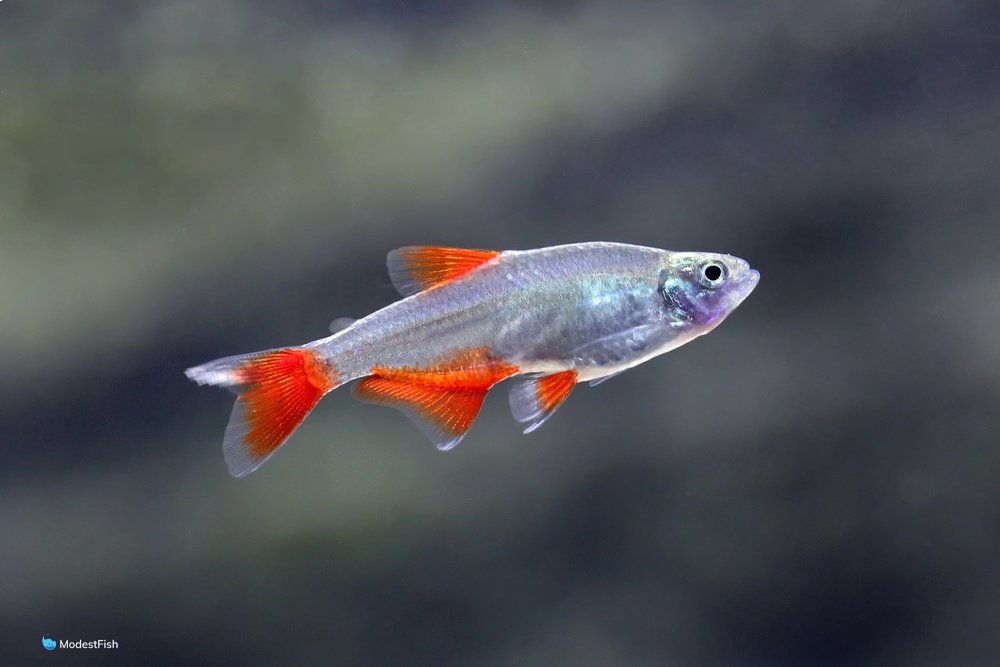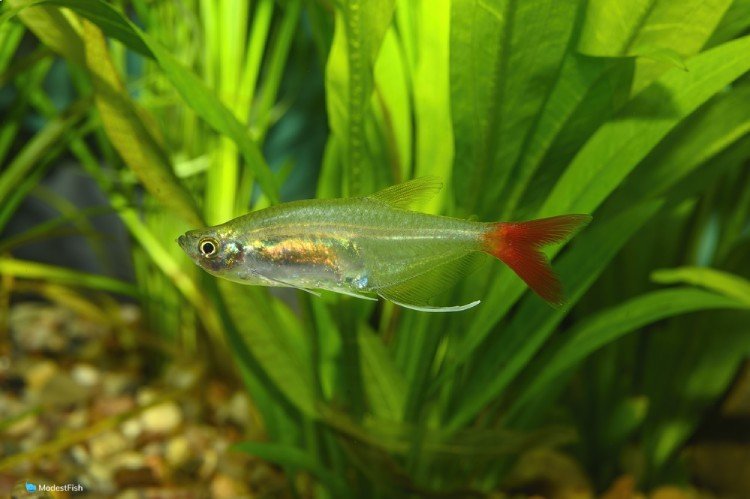The Bloodfin Tetra is perhaps one of the most underrated fish in its species due to the abundance of other popular Tetras. These freshwater nano fish have a distinct silvery-blue body and a striking orange-reddish tail that is bound to catch your attention as you skim through the pet store!
They’re considered great schooling fish and are relatively active, making them a super addition to a tank because of their peaceful disposition and ability to get on well with their species and other similar, small-school fish.
This care guide will give you the essential information you need to know how to care for Bloodfin Tetras.
Overview & Appearance: Bloodfin Tetra
Bloodfin Tetras (Aphyocharax anisitsi) originate in South America, specifically Argentina and Rio Parana. Their natural habitat is commonly shaded rivers and streams, with hanging vegetation and floaty greens.

Being schooling fish, they’re often found in groups and prefer the upper to mid-layers of water. They are only 2 ¼ inches, slim-bodied, and have beautiful colors, ranging from a subtly toned beige-orange to a more striking translucent silver, with shocking neon hues.
Their most unique characteristic is the stunning red tone on their anal and tail fin, which is how they got their Bloodfin name.
Care Stats Overview
These statistics will give you an outline of the primary information you need to keep your Bloodfin Tetra thriving and happy.
- Tank Size: 20-30 gallon tank
- Temperature: 64°F – 82°F
- pH: 6.0-8.0
- kH: 2-30 DgH
- Living Zone: Upper-mid dwellers
- Temperament: Peaceful
- Diet: Bloodfin Tetras are omnivores, so a diet consisting of high-quality flake food, brine shrimp, and bloodworms is preferred.
Scientific Classification
These South American fish have some interesting scientific facts that make them unique. Read on to find out about their scientific origins.
- Kingdom: Animalia
- Phylum: Chordata
- Class: Actinopterygii
- Order: Characiformes
- Family: Characidae
- Genus: Aphyocharax
- Species: Anisitsi
Life Span
Bloodfin Tetras are pretty long-lived fish if given good nutrition, cared for, and provided a good environment. On average, their life will span between 5-8 years, but at their best, they can live over 10 years.
Sexual Dimorphism: Size & Coloration
There aren’t many distinguishing features between Bloodfin Tetra males and females. Older males will show gill glands and hooks on their anal fins, but this isn’t found all the time.
Males will tend to sport a more vibrant red in their anal and tail fin, while females will have a more subtle red and a plumper body size, especially during breeding times.
Bloodfin Tetra Care & Tank Set-Up

Follow the below parameters to ensure that you get your tank in the perfect condition for your Bloodfin Tetras to enjoy.
Tank Size & How Many Can Be Kept Together
Bloodfin Tetras are schooling fish and like to be in large groups. A tank of about 20 to 30 gallons will cater for about 5 to 7 fish. A bigger tank will always be a safe option as these Tetras are active and like to swim around. Also, with the addition of vegetation and props, you will need a tank big enough to accommodate it all.
The Nitrogen Cycle
The Nitrogen Cycle is a biological system whereby nitrogen converts into a variety of forms. This natural system is essential because it keeps our ecosystem at an optimum level, necessary for fish to thrive.
Often beginner fish keepers overlook this factor in fish-keeping, known as new tank syndrome, and it can lead to a disaster if it’s skipped.
Fish naturally produce ammonia as a waste byproduct, and bacteria will change this waste into nitrites that will eventually convert to nitrates. Too many nitrates in your aquarium can cause fish to become weak and unhealthy.
To keep on top of nitrate levels, you should make an effort to keep the tank in good condition by changing the water often and wiping away excess algae. This practice will prevent your fish from contracting diseases through parasites.
An easy way to keep the water healthy in your tank is by adding live plants. Live plants will consume the nitrates present in the water for their plant nourishment.
You can also buy an aquarium test kit to keep on top of nitrate levels and then follow these guidelines for its usage.
Water Parameters for Bloodfin Tetra
Always keep in mind that consistency is vital when it comes to water parameters.
Maintaining stable conditions is more important than getting every measure to the tee. The water parameters below are there to guide you on what Bloodfin Tetras enjoy as their optimum.
- Temperature: Bloodfin Tetras do best in temperatures between 64°F – 82°F. This wide temperature range shows that these Tetras can adapt to most conditions. It’s key to remember to maintain a stable temperature, whichever you choose in the temperature range, and stick to it.
- pH: Aim to set the pH in your tank between 6.0 to 8.0. Try and keep on top of it by testing the pH levels frequently with a meter to ensure that they’re stable.
- kH: Aim to have the water hardness between 2 – 30 dGH.
- Hardness: Bloodfin Tetras will be fine in soft and hard water, but their optimum is 2-30 dgh. Adjust water hardness by adding some baking soda to the water; this will increase the hardness. If you find your water needs to be softened, you can use a shower head filter or an electronic water softener.
Tank Set-Up
Bloodfin Tetras require a tank replicating their natural environments. Begin with selecting a dark sand substrate for the tank bottom. Though these fish are upper to mid dwellers, it’s still essential to have a substrate that reminds them of home.
Dimly light your tank and decorate it with live plants, essential to Bloodfin Tetras as they like their “me-time” and will resort to places for hiding.
You can select both floating plants and static. A few examples that you could use are java moss and narrow leaf anacharis.
Purchase some artificial hideouts or tank props like plastic caves and rocks as additional hideout areas.
Lastly, aim to have slow-moving water as it mimics the habitat Bloodfin Tetras originate from. Also, ensure you have a good lid on top of your tank as they have a reputation for jumping, especially during breeding times.
Diet & Feeding
Giving a varied omnivore diet of worms, brine shrimp, and other meaty foods ensures a healthy diet for these fish.
Being relatively active, they need to be fed often, about 2-3 times a day, but avoid overfeeding, as it will cause them to get sick. Any foods they don’t consume will possibly sink to the bottom, so ensure you clean out any rotting food.
Behavior & Tank Mate Compatibility
Bloodfin Tetras are friendly and peaceful fish, which make them perfect additions to a community tank. They’re best in the company of fish with a similar disposition to them.
It’s a good idea to keep Bloodfin Tetras in a group of about 6 as they’re happier with their kind. Avoid keeping angelfish and guppies, though they’re also small, as Bloodfin Tetras have a reputation of nipping at their wavy fins.
Examples of good tank mates would be:
Bad tank mates would be fish known to be aggressive and have a reputation for injuring smaller fish.
Examples of bad tank mates would be:
- Flowerhorn
- Jaguar, Jewel, Red Devil, Umber, and Wolf Cichlids
- Mini Movie
- Oscar Fish
Breeding Bloodfin Tetras
The following steps should be taken when breeding Bloodfin Tetras:
- Ensure the pair have had a few days of good nutrition.
- Set another tank for breeding and place some plants for a dimmed light effect, allowing the pair to feel comfortable.
- Set the water temperature to the usual 64°F – 82°F that they’re accustomed to and place the pair in their separate tank.
- The pregnant female will look chubbier, and as she spawns, she will leap, and the eggs will drop in the tank.
- Once she’s done this, immediately remove the pair and place them back into the community tank as they might eat the fresh eggs.
It takes a few days for the eggs to hatch, and the new fry will receive nutrition from the yolk, so no need to feed them for a few days. Start with liquid dry food and then move onto baby brine shrimp.
Are Bloodfin Tetra Right For You?
Bloodfin Tetras are super additions to most community aquariums and are perfect when in a group. They’re active and love swimming around, so you’ll never get bored watching them. Though they’re small, they’re tough, so beginners shouldn’t have to worry about faffing around too much.
They interact well with other fish due to their peaceful disposition and can be paired up with many tank mates similar to them, creating a lively atmosphere in your tank.
They’re also easy to take care of, as long as you feed them regularly and provide a tank with leafy greens and consistent water parameters – they’re a pleasure to keep and care for.
